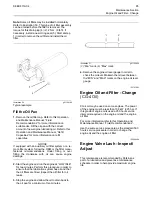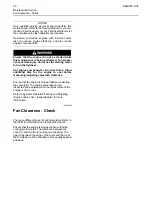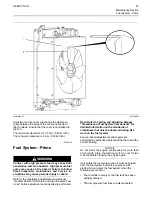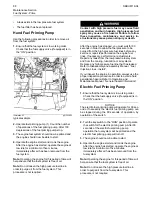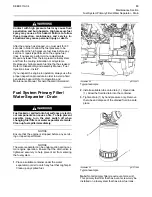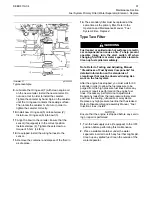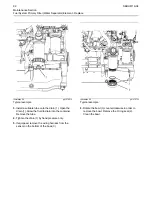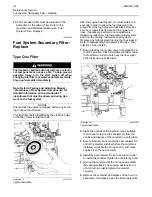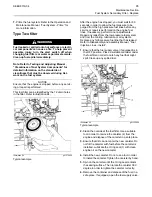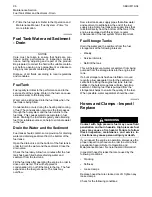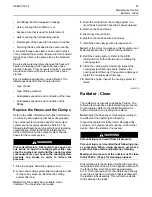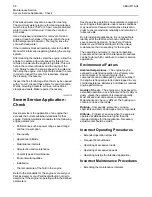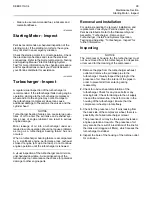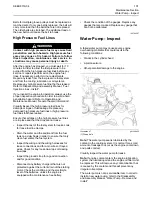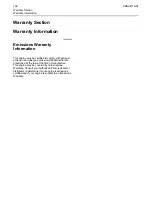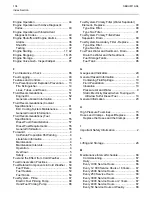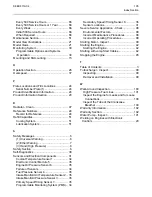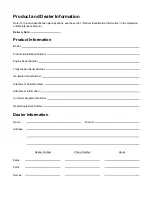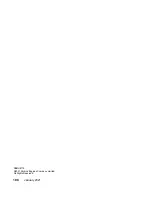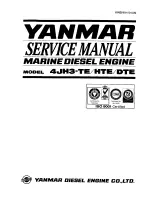
• Failure to use recommended fuel, lubricants and
coolant/antifreeze
i07888480
Starting
Motor
-
Inspect
Perkins
recommends
a
scheduled
inspection
of
the
starting
motor.
If
the
starting
motor
fails,
the
engine
may
not
start
in
an
emergency
situation.
Check
the
starting
motor
for
correct
operation.
Check
the
electrical
connections
and
clean
the
electrical
connections.
Refer
to
the
Systems
Operation,
Testing
and
Adjusting
Manual,
“Electric
Starting
System
-
Test”
for
more
information
on
the
checking
procedure
and
for
specifications
consult
your
Perkins
dealer
or
your
Perkins
distributor
for
assistance.
i04149590
Turbocharger
-
Inspect
A
regular
visual
inspection
of
the
turbocharger
is
recommended.
If
the
turbocharger
fails
during
engine
operation,
damage
to
the
turbocharger
compressor
wheel
and/or
to
the
engine
may
occur.
Damage
to
the
turbocharger
compressor
wheel
can
cause
additional
damage
to
the
pistons,
the
valves,
and
the
cylinder
head.
NOTICE
Turbocharger bearing failures can cause large quan-
tities of oil to enter the air intake and exhaust sys-
tems. Loss of engine lubricant can result in serious
engine damage.
Minor leakage of oil into a turbocharger under ex-
tended low idle operation should not cause problems
as long as a turbocharger bearing failure has not
occured.
When a turbocharger bearing failure is accompanied
by a significant engine performance loss (exhaust
smoke or engine rpm up at no load), do not continue
engine operation until the turbocharger is renewed.
A visual inspection of the turbocharger can minimize
unscheduled downtime. A visual inspection of the
turbocharger can also reduce the chance for potential
damage to other engine parts.
Removal and Installation
For options regarding the removal, installation, and
replacement, consult your Perkins dealer or your
Perkins distributor. Refer to the Disassembly and
Assembly, “Turbocharger - Remove and
Turbocharger - Install” and Systems Operation,
Testing and Adjusting, “Turbocharger - Inspect” for
further information.
Inspecting
NOTICE
The compressor housing for the turbocharger must
not be removed from the turbocharger for inspection
or removed for the cleaning of the compressor.
1.
Remove the pipe from the turbocharger exhaust
outlet and remove the air intake pipe to the
turbocharger. Visually inspect the piping for the
presence of oil. Clean the interior of the pipes in
order to prevent dirt from entering during
reassembly.
2.
Check for obvious heat discoloration of the
turbocharger. Check for any loose bolts or any
missing bolts. Check for damage to the oil supply
line and the oil drain line. Check for cracks in the
housing of the turbocharger. Ensure that the
compressor wheel can rotate freely.
3.
Check for the presence of oil. If oil is leaking from
the back side of the compressor wheel, there is a
possibility of a failed turbocharger oil seal.
The presence of oil may be the result of extended
engine operation at low idle. The presence of oil
may also be the result of a restriction of the line for
the intake air (clogged air filters), which causes the
turbocharger to slobber.
4.
Inspect the bore of the housing of the turbine outlet
for corrosion.
SEBU8119-04
99

